|
War in the Pacific
War in the Pacific National Historic Park Historic Resource Study |

|
F. OTHER SIGNIFICANT WORLD WAR II SITES ON GUAM
I. Camp Manengon
On the eve of the American invasion of Guam, the Japanese military, on July 10, 1944, ordered Guamanians to evacuate the west coast immediately and move to designated areas on the eastern side of the mountains. This was a hurried evacuation, involving the old, young, lame, and sick, and creating great hardship on the people. Many chamorros then believed (some still do) the Japanese were rounding them up to massacre them. Many atrocities had already occurred. More likely, the Japanese were deliberately removing them from the expected scenes of combat, as they did with the inhabitants of some other islands under seige during World War II. In Guam's case, this probably was not solely a humanitarian measure; the Japanese were aware that Guamanians would be sympathetic to the Americans when they landed and could provide valuable information concerning defense plans. Regardless of the motivations these forced marches over jungle trails and mountains were marked with great hardship, terror, even death. In the end, however, the evacuation saved many people from death on the battlefield. The concentration camps were located at Maimai, Tai, Manengon, Talafofo, Inarajan, and other places. The largest camp was at Manengon where more than 10,000 Guamanians, about half the island's population, were concentrated.
Manengon today is a peaceful, rural valley through which the Ylig River flows. Open areas are bordered by lush jungle. A scattering of residences line the lone, dead-end road that parallels the river. The area is privately owned. It is not possible to imagine the conditions of 1944, when 10,000 people camped on both sides of the river in a sea of mud. Palm leaves were the principal means of shelter from the incessant rains. People farther up the river polluted the water for those below because even the most primitive means of sanitation were unavailable. Japanese guards harassed the people over the slightest infraction of arbitrary rules. Food consisted of what people had succeeded in bringing in and the fruit of jungle trees. Fires were permitted only at night.
After the battle began, men and older boys at the camp were rounded up and taken away to carry ammunition and dig tunnels for the Japanese. Finally, when the Japanese guards were forced to leave because of American advances, they took 40 more men with them to carry provisions. In northern Guam, the Japanese tied these men's hands behind their backs and shot them. These bodies and other murdered men were discovered by U.S. forces in the final drive north. [13]
Several of the internees recorded their experiences at Manengon. Catalina G. Baza: "We were camped at Manengon, the men were gathered and he [friend] was included to carry some cargo for the Japanese." "When we got to Manengon, we camped there. We could not build a fire again, to cook our food, so the people could eat. Yes, we could build a fire but if the [American] airplane was coming we had to put out the fire." [14] She and some other women crossed the river against orders to get some clean drinking water in the Japanese guards' area. The Japanese took the women into custody but let them go later because it was their first offense.
Jose Baga: "When we came to Manengon, the Japanese ordered us to dig our holes, but I did not dig a hole because I thought to myself, 'My goodness, if have to dig my own grave. . .'" He said that the Japanese ordered all dogs killed. Other accounts said the Japanese ate the dogs.
Rosa Baza recorded of Manengon: "The Japanese camped us because it was their intention to kill us all."
Rosa Roberta Carter recalled that the Japanese ordered her parents and the eight children to march to Manengon, they traveled at night with the children in a cart pulled by a cow. Her father built a small shack with coconut leaves. The family survived on local fruit. Later, the Japanese rounded up the men and took them away.
Rosario M. Mafnas said that at Manengon each group had to dig a hole, "We were told that it was for hiding, but probably it was to bury us." Carlos K. Martinez remembered that the Japanese had three machine guns on a hillside at Manengon which were to be used to kill the people in the camp. The Guamanians, however, removed the "pins" from the guns.
Jesus Meno: The Japanese already knew that the Americans were going to land on Guam so they told all the Chamorros through written notices to clear the front area because the Americans were heading to bomb the beach areas." Juan Pangelinan: "I can't say that the Japanese were bad. Well, the only thing is that our communication [was poor?] of course, some Japanese were mean, some were just mean in the heart, some were just soft-hearted. Everywhere in the nation, some are good, some are mean, some have heart."
Regardless of Japanese intentions, Manengon was a hellhole. Medical supplies were limited or non-existent. Sanitation was unbearable. Inadequate food resulted in malnutrition. And people died.
The first Americans to reach the camp were a patrol of eight men led by Chamorros. By then, the Japanese guards had fled. When the patrol left to return to the Agat area, "the people just followed, one family, two families, three families, and then everybody started following. Well, some didn't follow, some just stayed behind in Manengon, but very few stayed." [15] At Agat, the Americans established a tent city for the refugees. It soon was overflowing and other refugee camps were set up, including one at Manengon.

|
| Camp Manengon, 1984. |
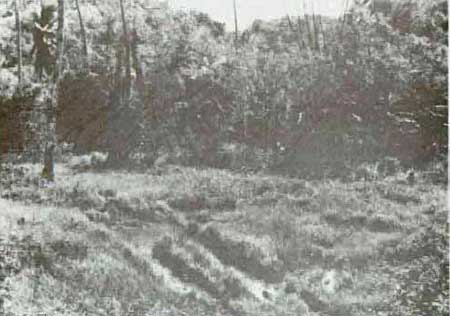
|
| Camp Manengon, 1984. |

|
| Manengon Valley. |

|
| Ylig River. |
II. Tweed's Cave
When the Japanese captured Guam in December 1941, six U.. 5. Navy men escaped into the jungle. Four were from the Radio Communications Center, Agana: Radiomen First Class Al Tyson and George Ray Tweed, Yeoman First Class A. Yablonsky, and Chief Aerographer L.W. Jones. The other two were crew members of USS Penguin a patrol craft that the Japanese had sunk on December 8: Chief Machinist Mate L. L. Krump and Machinist Mate First Class C.B. Johnston.
George Tweed had served in the Navy for 16 years. Just a few weeks earlier his wife and son had been evacuated from Guam along with other navy families. When the Japanese landed on December 10, Tweed jumped in his ancient car. He picked up Tyson on the road. The two drove about eleven miles southeast of Agana and hid the car in the jungle. They first hid in the Yona area on Guam's east coast. The other four men hid nearby in the Manengon area on the Ylig River, where later the Japanese concentrated Guamanians. Then, the six men stayed together for several weeks before deciding to divide into parties of two. The Japanese soon became aware of the men and issued orders that they surrender in 30 days or be beheaded. None surrendered.
In February 1942, Tweed and his partner split and Tweed was on his own. Jones, Yabonsky, and Krump were the first to be captured. Around July 1942 they were bayonetted and beheaded by the Japanese. Tyson and Johnston hid in the Oka Point area for six months where Father Jesus Duenas visited them once every four weeks. In October, the Japanese discovered and shot the two men. Tweed, expecting the arrival of the U. S. Navy at any time, was now on his own. It was later estimated that about 50 Guamanians aided the Americans throughout 1942.
During 1942 and early 1943, Tweed kept on the move, always aided by his Chamorro friends. By the end of 1942 he was hiding twelve miles north of Agana. He then moved to the rugged cliffs at Pugua Point where he built a shelter in an isolated crevice atop a huge rock formation. Here he continued to receive assistance from sympathetic Guamanians, at great danger to themselves. Eventually, some Chamorros, including Father Duenas, were executed for their suspected loyalty to the American sailor.
On July 10, 1944, Tweed succeeded in attracting the attention of two U.S. destroyers by signaling with homemade flags and a mirror. He was rescued, flown to the United States, and reunited with his family. Some Guamanians thought he should have surrendered long ago to prevent their people from being tortured. In the United States, Tweed was a hero. [16]
The Pugua Point area is federal property and is administered by the U.S. Navy.

|
| George Tweed's hideout, Pugua Point, May 1947. |
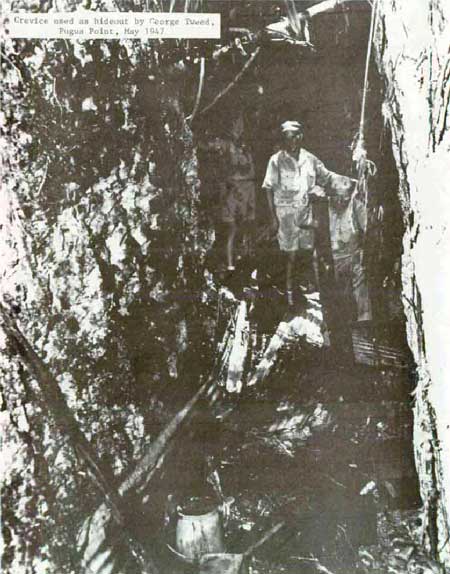
|
| Crevice used as hideout by George Tweed, Pugua Point, May 1947. |
III. Father Duenas' Execution Site
On capturing Guam, the Japanese sent all American military, civilians, and Roman Catholic clergy (including the Spanish Bishop Olano) to Japan as prisoners of war. They allowed two Chamorro priests, Fathers Jesus Baza Duenas and Oscar Lujan Calvo, and a Baptist minister, Rev. Joaquin Flores Sablan, to remain on the island. The Catholic Church had been on Guam for nearly four centuries and the removal of the clergy was a serious burden far the people to bear. Father Duenas, opposed to the techniques of the Japanese authorities from the start of the occupation, lived in the southern village of Inarajan and attended as best he could to the religious needs of all southern Guam. Japan sent two Catholic priests, Monsignor Fukahori and Father Petro Komatsu, to Guam to assist in religious matters and, presumably, to act as a bridge between the people and Japanese authorities.
Suspicious of Father Duenas because of his independent frame of mind, the Japanese considered at one time of exiling him to Rota. Only the intervention of Father Komatsu put an end to this idea. The Japanese priests and Duenas were not on friendly terms, however. On at least one occasion, Father Duenas criticized the Japanese for using the altar to praise Japan. Monsignor Fukahori, in turn, advised Duenas to stick to religious affairs. Eventually, Duenas refused to submit his sermons to Japanese censorship and to make official announcements for the occupiers during his sermons.
By early July 1944, it was clear to the Japanese that an American invasion of Guam was but a matter of time. On July 8, Japanese officials arrested the 30-year-old Jesuit, Father Duenas, in Inarajan, as well as his attorney-nephew, Eduardo Duenas. The two of them were tied and paraded through the village streets in front of their countrymen, who were ordered to be silent. Torture began almost immediately; water was forced into Duenas' nose and mouth, and both men were beaten. They were accused of being spies or the Americans and for helping navy man, George Tweed, who, ironically, escaped from Guam on July 10. Franciso Naputi was a witness to the event in Inarajan, "That morning . . . there was Father Duenas laid on a bench, being scourged. He was made to open his mouth while half a gallon of water was being poured into his mouth until he finished it. So many people there were crying, and whoever cried was scolded by the Japanese." [17]
Torture and interrogations continued over the next three days by various Japanese authorities. On the morning of July 12, Father Duenas, Eduardo Duenas, retired navy man Juan N. Panglinan, and an unidentified Chamorro were led to four fresh graves in the village of Tai, southeast of Agana. With their hands tied behind their backs, they were forced to kneel at the graves. One by one, Japanese officers moved forward and beheaded the men. Years later, Vincente Salas San Nicolas recalled that day:
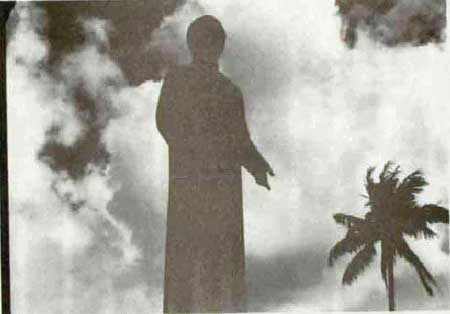
|
| Father Jesus Duenas Memorial, Tai, 1984. |
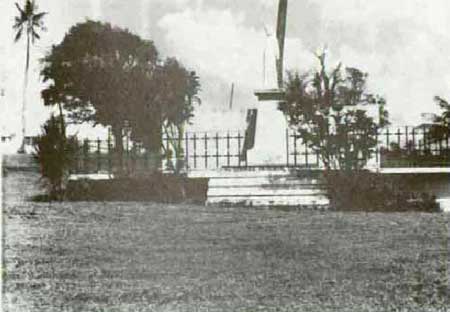
|
| Father Jesus Duenas Memorial, Tai, 1984. |

|
| Father Duenas Memorial School, from monument, 1984. |

|
| Father Duenas' burial site, altar, St. Joseph's Church, Inaragan, 1944. |
The notice came to us right after lunch that we had to go to Tai to watch the killing of three people by the Japanese, but we didn't get there in time. It had already been done; they'd been buried when we reached the place.
Q. Do you know who the three people were?
I don't really know who the people were because we were not there on time. But all the three were suspected of being spies and feeding Tweed so they were killed. [18]
Following the liberation of Guam, in March 1945, Father Duenas' remains were exhumed and moved to Inarajan. In a simple but impressive ceremony they were reburied beneath the altar in St. Joseph's church where they remain.
The site of the Tai killings is near today's Father Duenas Memorial School on Highway 10, just outside the community of Mangilao. Adjacent to the highway a statue of Father Duenas has been erected on a large grassy lawn with the school buildings in the background. Local people say that the statue is not on the precise spot of the killings but that it is close. There is no interpretation at the site. It is identified in a folder, "Guide to Guam's World War II Sites," which is readily avaiabie to visitors to the island.
IV. War Dog Cemetery
The War Dog Cemetery is 2.2 miles southwest of Vigo at V-paopao Estates on the north side of Highway 1. The small cemetery contains the graves of 24 war dogs who served in combat on Guam. The grassy plot is surrounded by a low iron-pipe fence, and a thicket of tangantangan hides the area from view. The grave markers are concrete, painted white, with an indented dog's profile painted black. Originally each marker identified the dog it represented. Now, however, the markers are blank. A 1947 photograph shows that a wooden fence originally surrounded the cemetery and a marker proclaimed it "Dogs of War" cemetery. At that time, the plot was part of a larger, landscaped area. Today, there is no marker on the highway to identify the site. After turning off the highway and driving a short distance in the community of Y-paopao Estates, one sees a metal sign that indicates the land leading to the cemetery. The U.S. Air Force maintains the area.
During the Guam campaign, the Third Marine Division employed 60 dogs in the battle. They engaged in three activities: message carrying, patrols, and night security duty. Because of the excellent radio communications, messenger dogs were rarely employed. Patrol dogs, however, were overworked, partaking in 454 patrols. In general, combat personnel were enthusiastic about employing the dogs in patrol and sentry duty, but the experience on Guam provided important lessons for future combat.
Before arriving in the Pacific, the patrol dogs had been trained on a leash. It was then discovered that leashed dogs made considerable noise in the jungle and their alertness was diminished. Retraining for off-leash patrolling had to be instituted. Many of the dogs were Doberman pinschers. As a rule, this breed proved unsuited for combat because it was highly tempermental and nervous. German sheperds, however, proved exceptionally suited to the work. Moreover, if its handler was taken out of action (casualties among handlers were high), the shepherd would readily respond to another handler. Most of the shepherds were less than pure bred, which was thought to contribute to their steadiness. A lone Labrador retriever worked exceptionally well in combat until killed. Contrary to popular thought, females stood up to combat conditions better than males. It was noted, however, that females should be spayed. One unforeseen problem was the tendency of the war dogs to destroy the local canine population.

|
| Marine war dogs moving up the front, Orote Peninsula, July 29, 1944. |

|
| War dog cemetery, near Yigo, 1947. |

|
| War dog cemetery, 1984. |
Of the Third Marine Division's 60 dogs, 9 were killed in action, 3 were missing in action, and 3 were wounded. The cause of death of the other 9 dogs buried in the cemetery is not yet known. Most likely they were dogs assigned to the First Provisional Marine Brigade. [19]
V. General Obata's Command Post
Lt. Gen. Hideyoshi Obata established his last command post on Guam at Mataguac Hill (Mount Mataguac in 1944) about a third of a mile north of Yigo. The hill rises 120 feet above the surrounding terrain. The command post's caves as well as a spring are in a depression on the northeast side of the hill. The history features are within the privately owned South Pacific Memorial Park, owned and managed by the South Pacific Memorial Association, composed primarily of Japanese citizens. At the east base of the hill, an imposing concrete memorial tower, in the form of hands in a praying gesture, dominates the scene. Nearby is the small Queen of Peace Chapel and a residence for a custodian. Japanese visitors continue to erect small monuments, shrines, and prayer sticks in the vicinity of the memorial. The park is dedicated to those Americans and Japanese who died in the battle for Yigo.
To the north of the memorial, a flight of concrete steps leads down into a large depression that contains the entrances to four caves where General Obata established his command post and where he and his staff died. A second flight of steps descends to a spring that provided fresh water to the Japanese. The water is collected behind a low concrete wall. Jungle vegetation is thick and lush throughout the depression except where trails are kept clear.
Mataguac Hill is covered with tall sword grass. Erosion has occurred on the slopes of the hill. Several iron stakes for barbed wire are found on the eastern slope; these appear to be American and post-battle.
The management of the park provides some written interpretation of the memorial, some of it in fractured English, but there is little information available an General Obata's last stand or on the battle for Yigo and Mount Santa Rosa.
Lt. Gen. Hideyoshi Obata, from his headquarters on Saipan, commanded the Thirty-first Army which defended the Mariana, Bonin, and Palau islands. He was on an inspection trip to Palau when the American invasion of Saipan began. The general hastened to return to his headquarters but was unable to proceed beyond Guam. Despite his seniority, Obata left Guam's defenses in the hands of the island commander, Lt. Gen. Takeshi Takashima. When Takashima was killed on July 28, Obata took command of the surviving Japanese forces on Guam and oversaw the withdrawal to the north. There, he established a final defensive line in the Mount Mataguac-Mount Santa Rosa area. Chamorro men were forced to dig tunnels for Obata's command post under Mount Mataguac. Joaquin Acosta Blas recalled later that the Japanese forced him and other Chamorros to build three tunnels at Mataguac.
On August 10, 1944, patrols from the Seventy-seventh Infantry Division approached Mataguac and drew heavy fire from the Japanese. A full-scale battle ensued. Obata knew the end was near and radioed his last messages to Japan, "I will engage the enemy in the last battle with the remaining strength at Mount Mataguac tomorrow, the 11th." [20] Next morning a battalion of U.S. infantrymen, supported by tanks, assaulted the hill. Then, behind a shower of grenades, they descended into the depression where they sealed the caves with explosives. Sometime that morning General Obata took his own life. The bathe for Guam was over.
Four days later, demolition men reopened the caves and found more than 60 bodies within. The U.S. Army described the caves as having four-foot thick concrete walls; they were large and elaborately constructed; and they contained a large transmitter. It is not known if the caves were resealed or collapsed later.

|
| Entrance to South Pacific Memorial Park, Mataguac, 1984. |

|
| Mataguac Hill in background, Queen of Peace Chapel to left, Memorial Tower to right, 1984. |
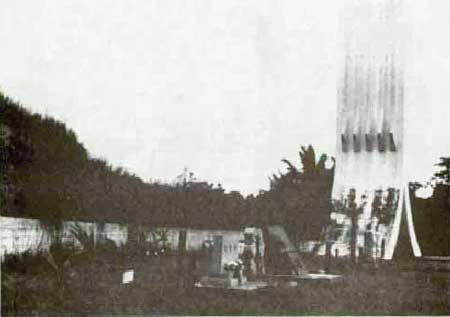
|
| Memorial Tower, Mataguac Hill, 1984. |

|
| Interpretation at Mataguac Hill, 1984. |
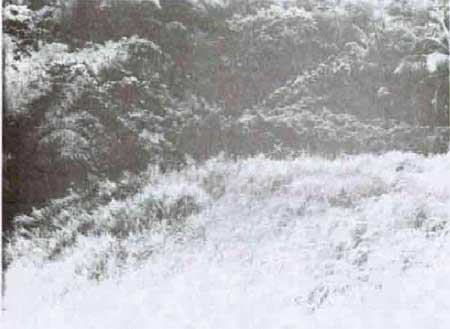
|
| Command post depression, Mataguac Hill, 1984. |

|
| Cave in command post area, Mataguac Hill, 1984. |
VI. Agana Tunnels
These tunnels or caves were dug by the forced labor of Chamorros for the benefit of the Japanese occupants of the capital, Agana. They are at the bottom of the limestone cliff, Kasamata Hill, an which the postwar Government House is situated. Nearby is the concrete bunker the Japanese cut into the cliff to serve as a communications center. It is essentially one large room having some partial partitions of concrete. There are three entrances to the bunker, two of which are adjacent to each other. Japanese characters are inscribed in the concrete above the two. Painted metal gates have been placed at the entrances. One feature at the bunker which is unique to Guam but found elsewhere in the Pacific is a number of oil drums that the Japanese filled with concrete to provide protection to the entrances. The metal drums have eroded away leaving their ghosts on the concrete cylinders. The bunker is essentially the same kind of structure as found on Fonte Plateau. Neither the bunker, nor the tunnels have any on-site interpretation.
VII. Hill 40
Hill 40 is a small mound, about 40 feet in elevation, just inland (east) of Bani Point. It is surrounded by a residential development and is extremely difficult of access. It can barely be glimpsed from the highway. It is outside the park boundaries. The only evidence remaining from World War II is a few shell craters amongst its thick vegetation.
On July 21, W-Day, 1944, the 1st Battalion of the 4th U.S. Marines landed on Beach White 2 at Agat, the beach nearest to Bangi Point and Hill 40. When the battalion had advanced 700 yards inland, one company turned right and attacked Hill 40. Japanese machine gun fire met the invaders and marine tanks were called in to subdue the defenders. No Japanese artillery fire was reported as having come from the hill, which was taken well before noon. That night, the Japanese launched a counterattack along the Agat beaches. Company K, 4th U.S. Marines, holding Hill 40, was driven from its positions twice, but twice recovered the lost ground. To the Japanese and U.S. Marines who fought there, Hill 40 was etched in their memories.

|
| Japanese communications center, Agana, 1984. |
| <<< Previous | <<< Contents >>> | Next >>> |
wapa/hrs/secf.htm
Last Updated: 07-Mar-2005